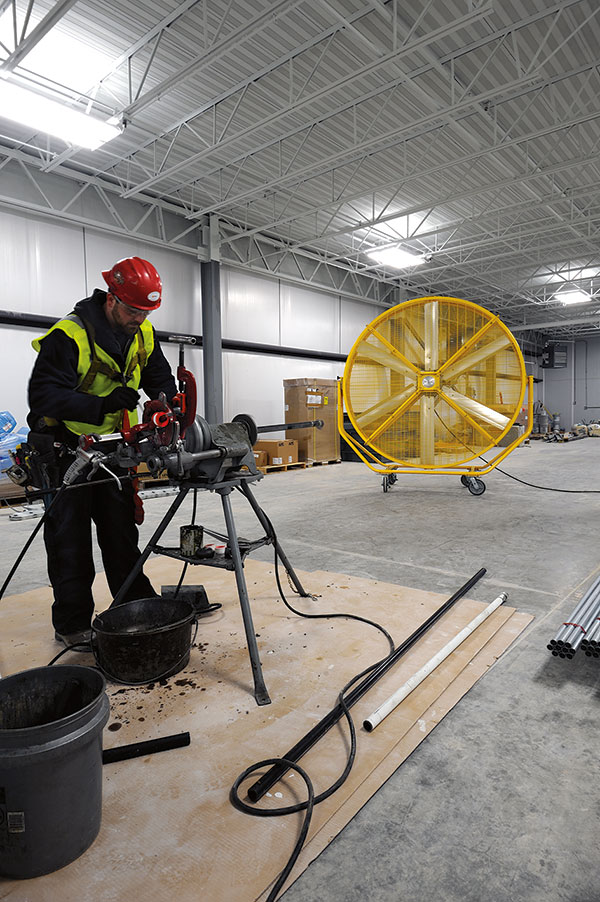Lack of air movement on construction sites can exacerbate safety problems associated with heat and air quality, and makeshift solutions can create new issues, such as noise control and fire hazards. Since workers are typically on construction sites only temporarily, mobile fans that supervisors can bring to every jobsite are ideal for continuous air movement needs. Durable, portable fans can be used to help create healthy and productive work environments in any location. In more permanent facilities such as warehouses used to store construction equipment and vehicles, large-diameter overhead fans maximize air movement and energy efficiency.
Heat Safety
Whether workers are directly in sunlight or inside a sweltering building, stagnant air can create health and safety hazards. Along with the lack of air movement, the layers of protective clothing construction workers often must wear add a challenge to keeping workers cool.
According to OSHA, air temperatures exceeding 95 F significantly increase the heat load on the body, and temperatures of 100.4 F and above are dangerous for workers. This increased heat load can lead to heat-related illnesses and a difficulty focusing, resulting in a higher potential for safety issues in construction zones.
Besides being unsafe, discomfort can also have a negative impact on productivity. Studies show that elevated temperatures affect both physical and mental work. Hot working conditions negatively affect worker morale and quality of workmanship and can increase absenteeism, turnover and frequency of accidents and grievances.
Fans engineered to withstand harsh work environments, such as construction sites, make workers feel up to 10 F cooler, leading to safety and productivity benefits.
 Fan Mobility
Fan Mobility
Mobility allows for flexibility in any environment, from open-air treatment plants and accompanying warehouses to construction sites. Employees at the City of Tampa Advanced Wastewater Treatment Plant sweltered in the underground 6,900-sq.-ft. facility. To help ensure employee comfort and safety, plant team leader Eddy Drovie turned to a mobile eight-ft.-diameter fan built to withstand tough environments. Using a crane, the fan was lowered into the tank and rolled from bay to bay following the workers. “The fact that you can move those fans around is a plus,” says Drovie. “I think that’s a big part of the reason why we chose this.”
Air Quality
Air quality is often an issue on construction sites. Dust and dirt is often stirred up on jobs, and construction materials may contain harsh chemicals and toxins. Poor air quality can contribute to decreased focus in workers, leading to costly mistakes and health problems. Adequate indoor air quality is primarily important in the occupant breathing zone, which is defined as the area three to 72 inches from the floor. According to the Center for the Built Environment, temperature and air quality are two of the most important factors when considering productivity. Properly sized fans can turn the air over several times per hour, creating uniform air distribution and improving health conditions for workers.
Employees at the Environmental Service Center (ESC) Household Hazardous Waste drop-off facility in Houston, Texas, sought a breath of fresh air after inhaling vapors ranging from exhaust fumes to chemicals and pesticides. In order to combat the problem, ESC facility manager Roger Jones turned to fans and increased air movement. An eight-ft.-diameter vertical fan offered both massive air movement and easy transportation throughout the facility, ensuring dilution of the gases dispersed in the air.
“These fans make a big difference,” Jones said. “We deal with not only the ambient temperature but the odors from all those chemicals we handle, and the fans help move those odors out of our breathing zone.”
With so many different fan sizes, options and features, it may be difficult to know what type of fan is appropriate for your space and needs. Look for a fan that is designed by a company that understands your needs. There’s no one-size-fits-all solution, so being able to work with somebody who recognizes what you’re trying to achieve is important.
Additional Benefits
In addition to reducing heat-related troubles and air-quality issues, fans can also help reduce safety hazards in other ways. In some cases a single high-quality fan can replace several smaller fans, reducing noise and trip hazards presented by cords on the floor. Some fans include misting options, which create ultra-fine atomized mists that have the cooling effect of up to 22 tons of air conditioning without making you feel wet. Selecting a fan that is built to withstand harsh environments reduces the chance for safety-related catastrophes and hindrances.



